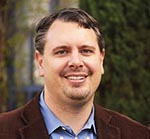Scientific Visualization Expert Dr. Hank Childs Joins CIS Department

The CIS Department welcomes its newest faculty member, Assistant Professor Hank Childs.
Dr. Childs' research focuses on scientific visualization, high performance computing, and the intersection of the two. Recent research results have explored using hybrid parallelism techniques (i.e. combining shared- and distributed-memory techniques) on scientific visualization algorithms, techniques for simplifying very large data sets so they can be more readily understood, and the design of visualization algorithms that can scale to tens of thousands of CPUs and beyond.
Dr. Childs received his Ph.D. in computer science in 2006 from the University of California at Davis. He comes from the Visualization Group at Lawrence Berkeley National Laboratory and the Institute for Data Analysis and Visualization at UC Davis, both since 2009. From 1999 to 2009, he worked at Lawrence Livermore National Laboratory, where he was a founding member and the project architect of the VisIt project. VisIt is used to visualize the biggest data sets on the world's largest supercomputers and has been downloaded over 200,000 times. Additionally, Childs has served as the Chief Software Architect of three different multi-institution projects, including VACET, an $11M, five year grant for the Department of Energy's Office of Science. Currently, Childs is a member of the executive council for SDAV, a fourteen institution, $25M, five year effort, tasked with enabling scientific discovery for the Department of Energy's biggest supercomputers via data management, data analysis, and scientific visualization tools. Finally, Childs is the co-editor of a new book, titled High Performance Visualization, available this month.
In July of 2012, Dr. Childs received the Department of Energy's Early Career Award, a five year, $2.5M grant. This work focuses on visualization on exascale computers, i.e., computers that can do 10^18 floating point operations per second. These machines will be particularly challenging to use, as they will utilize billions of cores and be extremely power constrained.
Assistant Professor Childs will start at UO in the spring of 2013, but will also retain a role at Lawrence Berkeley National Laboratory. He is coming to the university with significant funding and will be actively seeking out graduate students interested in scientific visualization and/or high performance computing. For more information about Professor Childs, please visit http://vis.lbl.gov/~hrchilds.